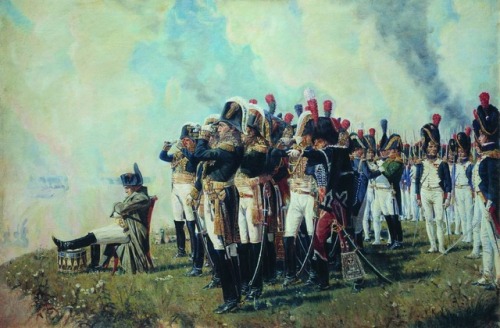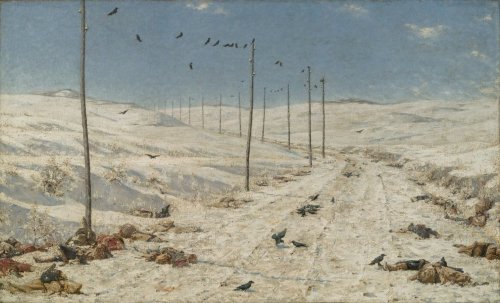#vasily vereshchagin

Apotheosis of War, Vasily Vereshchagin in 1871.
Vasily Vereshchagin depicted war atrocities in many of his paintings. He illustrated many wars including the Russo-Turkish War of 1877-88, 1857 Indian War of Independence titled ‘Blowing from Guns in British India’. His painting “The State Procession of the Prince of Wales into Jaipur.” , inside Kolkata’s Victoria Memorial is the third largest painting in the world. Vasily always depicted real side of war despite the rising propaganda of obscuring failures and highlighting glories. Due to this, he experienced opposition from Russian Empire, some countries of western Europe and British rule in India. He painted ‘Apotheosis of War’ in 1871. The painting depicts a pyramid of human skulls on the background of the ruined city and denuded trees among the red hot plain. Flocks of hungry birds of prey fluttering over the pyramid, picking at their remains. Death and destruction are conveyed with extreme detail through skulls. The denuded trees represent a civilisation without humanity. The leaves of kindness and compassion have fallen. The ravens symbolises irrationality. People driven by their self interest and insatiable thirst for power, iniate wars that leads to people becoming victim of their insanity. In the background, we can see ruined remains of a fortress, conveying grief and destruction that war brings on their families. Vasily used yellow and light brown colour for the barren plain and background, juxtaposing the horrors of war. Contrasting the dull plain, clear blue sky and shining sun only emphasizes the dreadness of the picture and present us a world where we don’t want to live in. Vasily not only portrays the abhorrent nature of mass death but also emphasizes a single lost life. The pyramid of skulls shows a fragile social and political strucure built on the foundation of mistrust, self interest and hate.
Vasily is trying to show the realistic picture of war to poets and prophets who dreamt of a utopia in which war will not exist and peace will reign on earth. It can be misunderstood by some as glorification of war, but he condemns the war by showing us its brutal nature. He tries to show that men are dynamic creatures who can’t live contended merely with peace. These men don’t think about the post calamities of war but are guided by their accumulated energy filled with ignorance and hate. The tendency of modern wars becoming global is pretty disturbing to us. The fact that radical difference in policies and abhorrent political ideologies of countries cannot always be settled by mere discussion, puts us as a civilisation into a bleak and uncertain future. I do not know how many wars could be prevented by art, but i do know that any stable, lasting peace depends on creating societies with a richness of opportunity and variety that can meet human needs.
Anatoly Shepelyuk. M.I. Kutuzov at the command post on the day of the Battle of Borodino. (Left)
1951.
Vasily Vereshchagin. Napoleon Near Borodino. (Right)
1897. Museum of Patriotic War of 1812, Moscow.
TheFrench invasion of Russia, known in Russia as the Patriotic War of 1812, and in France as the Russian Campaign, began on 24 June 1812 when Napoleon’s Grande Armée crossed the Neman River in an attempt to engage and defeat the Russian army. Napoleon hoped to compel Tsar Alexander I of Russia to cease trading with British merchants through proxies in an effort to pressure the United Kingdom to sue for peace. The official political aim of the campaign was to liberate Poland from the threat of Russia.
The campaign was a turning point in the Napoleonic Wars. The reputation of Napoleon was severely shaken, and French hegemony in Europe was dramatically weakened. The Grande Armée, made up of French and allied invasion forces, was reduced to a fraction of its initial strength. These events triggered a major shift in European politics. France’s ally Prussia, soon followed by Austria, broke their imposed alliance with France and switched sides. This triggered the War of the Sixth Coalition.
TheBattle of Borodino was a battle fought on 7 September 1812. Although the Battle of Borodino can be seen as a victory for Napoleon, some scholars and contemporaries described Borodino as a Pyrrhic victory for the French, which would ultimately cost Napoleon the war and his crown, although at the time none of this was apparent to either side.
This victory ultimately cost Napoleon his army, as it allowed the French emperor to believe that the campaign was winnable, exhausting his forces as he went on to Moscow to await a surrender that would never come. The Borodino victory allowed Napoleon to move on to Moscow, where — even allowing for the arrival of reinforcements — the French Army only possessed a maximum of 95,000 men, who would be ill-equipped to win a battle due to a lack of supplies and ammunition. The Grande Armée suffered 66% of its casualties by the time of the Moscow retreat; snow, starvation, and typhus ensured that only 23,000 men crossed the Russian border alive. Furthermore, while the Russian army suffered heavy casualties in the battle, they had fully recovered by the time of Napoleon’s retreat from Moscow; they immediately began to interfere with the French withdrawal, costing Napoleon much of his surviving army.
Post link

The Apotheosis of War, Vasily Vereshchagin, 1871
Stop war!
@xxxx[{:::::::::::::::::::::::::::::::::>
Апофеоз войны
Vasily Vereshchagin,La apoteosis de la guerra. “Dedicado a todos los conquistadores, pasados, presentes y por venir”.1871





